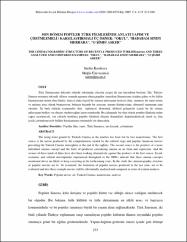Son Dönem Popüler Türk Filmlerinde Anlatı Yapısı ve Çözümlemeli/Karşılaştırmalı Üç Örnek:"Okul","Hababam Sınıfı Merhaba”, “O Şimdi Asker”
Abstract
Türk Sinemasının doksanlı yıllarda yakaladığı yükseliş çizgisi iki ana kaynaktan beslenir; İlki, Türkiye Sinema ortamına seksenli yılların sonunda egemen olmuş popüler Amerikan Sinemasının izinden giden ve bu kültür kuşatmasının ürünü olan filmler, ikincisi daha kişisel bir sinema anlayışının üreticisi olan, sinemayı bir sanat formu ve anlatım aracı olarak benimseyen, belirgin biçimde bir arayışın, sinema düşüncesinin, alternatif sinemanın izini sürenler. İki binli yıllarda yaşanmakta olan toplumsal, ekonomik, kültürel gelişmeler içinde bu iki sinema anlayışının birlikte var olmayı sürdüreceğine işaret etmektedir. Bu çalışmada, bir olgu olarak popüler filmlerin anlatı yapısı incelenecek, son yıllarda üretilmiş popüler filmlerin oluşum dinamikleri değerlendirilecek örnek üç film içerik çözümlemesiyle birlikte karşılaştırma yöntemiyle ele alınacaktır The rising trend gained by Turkish Cinema in the nineties has been fed by two mainstreams. The first source is the movie produced by the comprehension created by the cultural siege and popular American movies prevailing the Turkish Cinema atmosphere at the end of the eighties. The second source is the products of a more individual cinema concept and the fruits of producers considering cinema an art form and expression. And the owners of those kinds of films have also been working alternatively against the products of the first source. Social, economic and cultural developments experienced throughout in the 2000& #8217; s indicate that these cinema concepts mentioned above are likely to keep coexisting in the forthcoming years. In this study the cinematographic structure of popular movies are to be examined, the formation of popular movies produced in the last years are to be evaluated and also three example movies will be substantially analyzed and compared in terms of content analysis.


















